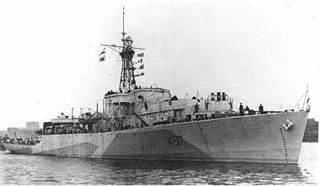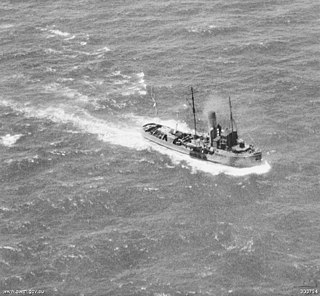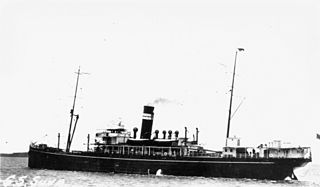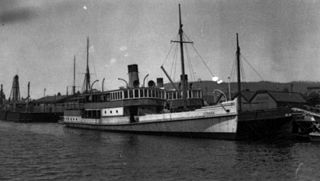USS Cheyenne, a converted tug, was launched in 1885 by Sam Paegnall, Charleston, South Carolina; acquired by the United States Navy on 8 July 1898 as SS Bristol and renamed Cheyenne. Outfitted at Charleston Navy Yard, she was commissioned on 30 July 1898, Lieutenant G. H. Swan in command, and reported to the Auxiliary Naval Force.

HMAS Kurumba was an oil tanker operated by the Royal Australian Navy (RAN) from 1919 to 1946.

HMS Loch Morlich was a Loch-class frigate that never saw service with the Royal Navy. Ordered during World War II, she saw service instead with the Royal Canadian Navy in the Battle of the Atlantic. She was named for Loch Morlich in Scotland. After the war she was returned to the Royal Navy and she was sold to the Royal New Zealand Navy and renamed Tutira.

Forceful is a sea-going tugboat built for the Queensland Tug Company by Alexander Stephen and Sons Ltd in Govan, Scotland in 1925. She worked at her homeport of Brisbane, Australia between 1926 and 1970 berthing ships and assisting nearby casualties. During World War II she was commissioned into the Royal Australian Navy in early 1942 as HMAS Forceful (W126), based at Fremantle and Darwin, until returning to commercial service in October 1943. She is preserved as a museum ship at Brisbane.
USS Evea (YT-458), originally the sixth USS Resolute (YT-458), later YTB-458, was a United States Navy tug in commission from 1943 to 1944.

HMAS Heros was a tugboat which was operated by the Royal Navy (RN), Royal Australian Navy (RAN) and the Australian shipping firm J. Fenwick and Co. She was built for the RN in 1919, was sold to J. Fenwick and Co. in 1925 and was commissioned into the RAN between 1941 and 1942 and 1943 and 1947 before being scrapped in 1966.

HMAS Doomba was a Royal Australian Navy (RAN) warship of World War II. Built for the Royal Navy around the end of World War I as the Hunt-class minesweeper HMS Wexford, the ship only saw two years of service before she was decommissioned in 1921 and sold to the Doomba Shipping Company. The vessel was renamed SS Doomba, converted into a passenger ship, and operated in the waters around Brisbane until 1939, when she was requisitioned by the RAN for wartime service. Serving first as an auxiliary minehunter, then an auxiliary anti-submarine vessel, HMAS Doomba was purchased outright by the RAN in 1940, and served until early 1946, when she was sold and converted into a linseed oil lighter. Doomba was scuttled off Dee Why, New South Wales in 1976.

Palatka (YTB-801) was a United States Navy Natick-class large harbor tug named for Palatka, Florida.

HMAS Grantala was a hospital ship operated by the Royal Australian Navy (RAN) during World War I. She was launched in 1903 by Armstrong Whitworth Company for the Adelaide Steamship Company. The ship operated in Australian waters from 1903, and was requisitioned by the RAN on 7 August 1914. She was returned to her owners in 1915, then was sold and renamed Figuig. The ship was scrapped in 1934.

HMS Suva was an Armed boarding steamer of the Royal Navy during World War I. She was also commissioned briefly into the Royal Australian Navy before being returned to her owners. She was sold in 1928 and renamed Sirius and sold again in 1929 and renamed Bohol. An Imperial Japanese air raid on Manila in 1942 during the Second World War sank her.

HMAS Phillip was a depot tender of the Royal Australian Navy (RAN) between 1916 until 1921.
HMAS Mombah was a coal lighter and stores ship of the Royal Australian Navy (RAN) between 1923 and 1930 and later during the Second World War between 1944 and 1948.
HMAS Mollymawk was a tugboat of the Royal Australian Navy (RAN) between 1946 and 1957. She was then transferred to the Australian Army and was operated by the 32nd Small Ship Squadron, Royal Australian Engineers. In 1963 she was sold to Newsprint Mills Ltd in Hobart, Tasmania and was renamed Kallista.

HMAS Koolonga was a 4,260 gross tons cargo ship built by Sunderland Shipbuilding Company, South Dock Sunderland, England, in 1914 and bought by McIlwraith, McEacharn Line Pty Ltd, Melbourne and named SS Koolonga. She was requisitioned by the Royal Australian Navy on 6 August 1914, as a collier and supply ship. She was returned to her owners in late 1915. She was sold in 1937 to Madrigal & Company, Philippines and renamed Paz. She was scuttled during the Second World War at Sourabaya Harbour in 1942 and was later salvaged by the Imperial Japanese and renamed Hatsu Maru. While at anchor in Manila Bay, Philippines on 13 November 1944, she was attacked by United States Navy carrier aircraft and was sunk.
SS Alacrity was a tug built in Graville, France in 1893 as Jean Bart and was operated by the Dunkirk Chamber of Commerce. She was sold in 1902 to Howard Smith and renamed Alacrity for tug service in Port Phillip, Australia. During the First World War, she was purchased by the Royal Australian Navy in 1917 for use as a patrol vessel, inspection vessel, and minesweeper based at Fremantle. She was never commissioned. After being sold in 1925, she was slated for breaking up and was moored in Jervoise Bay, Western Australia, until a fierce gale in Cockburn Sound wrecked her in 1931.
HMAS Cerberus is the name given to a number of Royal Australian Navy ships and shore establishments, after the mythological Cerberus.
HMAS Kooronga was a 60-ton tug boat and training ship operated by the Royal Australian Navy (RAN). She was constructed at the Williamstown Dockyard, Victoria in 1917. Kooronga was commissioned on 6 June 1924 and named Cerberus II as a tender at the Flinders Naval Depot. The vessel was later renamed HMAS Kooronga. She ran aground in the Port Phillip channel and was stranded from 28 June until 14 July 1940. Upon being refloated she was refitted out.
HMAS Elwing was a tug boat operated by the Royal Australian Navy (RAN) during World War II.
The Sudbury II was a salvage and rescue tug that served during World War II with the Royal Australian Navy as Caledionian Salvor, however was never commissioned. She was sold in 1958 to Island Tug & Barge Ltd, Vancouver, renamed Sudbury II, and registered as a Fijian vessel. Sudbury II undertook numerous salvage jobs in the Pacific Ocean. She was sold in 1981 and became a fishing vessel and renamed Lady Pacific.

HMS Advantage was a Favourite-class tugboat of the Royal Navy during the Second World War. Built in the United States, she was transferred to the Royal Navy under Lend-Lease. Advantage served until the end of the war with the Royal Navy and was returned to the United States postwar. Sold to a Chinese merchant shipping company, she served successively as 109, Ming 309, and Kaoshiung until her 1965 scrapping.










